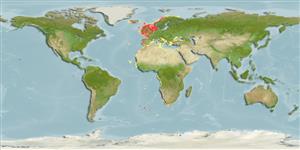Common names from other countries
Environment: milieu / climate zone / depth range / distribution range
Ecologie
; brakwater; diepteverspreiding 0 - 200 m (Ref. 435), usually 6 - 40 m (Ref. 435). Temperate, preferred 12°C (Ref. 107945)
Eastern Atlantic and the Mediterranean: from northwest Morocco to Atlantic coast of Europe.
Length at first maturity / Size / Gewicht / Leeftijd
Maturity: Lm 11.0 range ? - ? cm Max length : 20.0 cm CL mannelijk/geslacht niet bekend; (Ref. 435)
This is the most important edible crab fishery in Europe (Ref. 2762). Maximum depth from Ref. 106870. Occurs from the intertidal area to a depth of 100 m, common at depths 6 to 40 m (Ref. 435). Regularly found just above low tide mark. Found in an estuary (Ref. 106870). Inhabits rocky or sandy bottom (Ref. 96377). Carnivore; trophic level 3.1 (Ref. 96418).
Members of the order Decapoda are mostly gonochoric. Mating behavior: Precopulatory courtship ritual is common (through olfactory and tactile cues); usually indirect sperm transfer.
Fischer, W., G. Bianchi and W.B. Scott (eds.). 1981. (Ref. 435)
Status op de Rode Lijst van het IUCN (Ref. 130435)
Status bij CITES (Ref. 108899)
Not Evaluated
Not Evaluated
Gebruik door de mens
Visserij: commercieel
FAO - Visserij: landings, soortsprofiel | FishSource | Sea Around Us
Tools
Internet-bronnen
Estimates based on models
Preferred temperature
(Ref.
115969): 8.1 - 12.5, mean 10.4 (based on 518 cells).
Weerstandsvermogen
Hoog, minimale populatieverdubbelingstijd minder dan 15 maanden (K=0.24-0.46).
Prior r = 0.46, 95% CL = 0.31 - 0.69, Based on 2 data-limited stock assessments.
Kwetsbaarheid
Low vulnerability (10 of 100).
